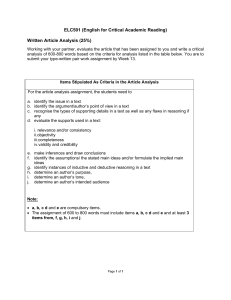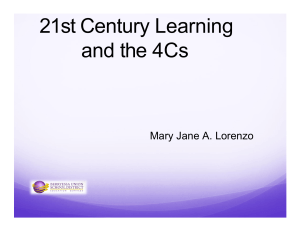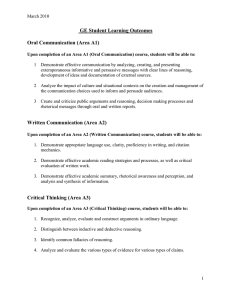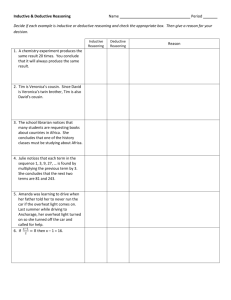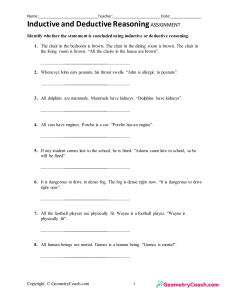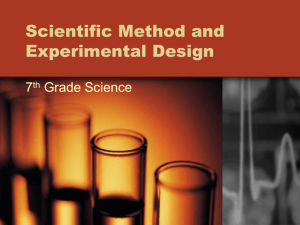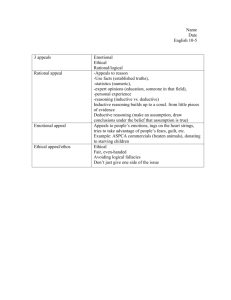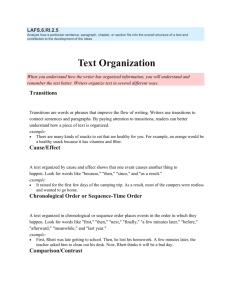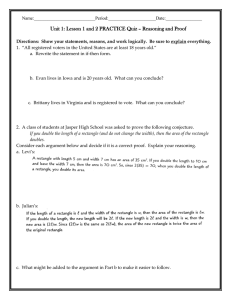Critical Thinking: Teaching and Assessment
advertisement
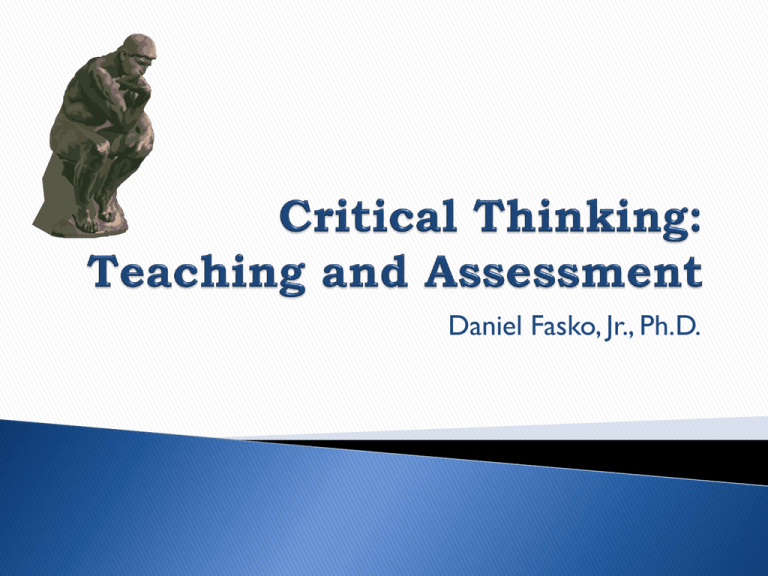
Daniel Fasko, Jr., Ph.D. Definition of Critical Thinking Critical Thinking Skills Critical Thinking Dispositions Instructional Strategies Assessment Techniques Review of Samples of Syllabi Refers to the skills of reflective intelligence used in making decisions about what to believe and what to do. (R. Ennis, 1996) This is the definition I will use for this colloquia. There are many other definitions too numerous to discuss today. (See Fasko, 2003.) • • • • • • • • • Optimism Confidence Acceptance of Ambiguity & Uncertainty Wide Range of Interests Flexibility Tolerance of Complexity Curiosity Persistence (but not stubborn persistence) Independence Distinguishing Fact from Opinion Determining the Reliability of Sources Clarifying Evaluating Comparing and Contrasting Sequencing Noting Similarities & Differences Distinguishing Relevant from Irrelevant Facts Making Predictions Recognizing Contradictions Exploring Implications Recognizing Statements that are Provable (Brookfield, 1987) Self-Regulation • • • • • • • • • Seeking a Clear Statement of the Thesis or Question Seeking Reasons Being Well Informed Using and Noting Credible Sources Considering the Total Situation Remaining Relevant to the Main Point Keeping in Mind the Original or Basic Concern Curiosity Self-Confidence • • • • • • Look for Alternatives Being Open-minded* Taking and/or Changing a Position when the Evidence is Sufficient to do so Seeking Precision Dealing in an Orderly Manner with the Parts of a Complex Whole Being Sensitive to the Feelings, Levels of Knowledge, and Degree of Sophistication of Others Ensure that students process information. Ask broad, open, and higher-order (How & Why) questions. (Use Socratic Method.) After asking questions wait at least 4-5 seconds before calling on students. Probe student responses by asking for: clarification, elaboration, evidence.* Use arguments. “Fishbowling” • • • • • • • Have a clear purpose for and plan of activities (active learning) to accomplish it. Model problem solving and thinking processes. Encourage students to ask questions of their own. Promote open discussion in groups. Play “Devil’s advocate”. Course topics should refer to practical situations that students can relate to Use a consistent thinking skills vocabulary. • • • • • • • • • • Infer Conclude Criteria Point of view Relevance Issue Contradiction Credibility Evidence* Prioritize • • • • • • • • • • Distinguish Elaborate Justify Perspective Interpret Analyze Synthesize Explain Compare Summarize • • • • • • • • • Hypothesize Relate Problem solve Make decisions Main idea Predict Derive Classify Evaluate • • • • • • • • Ask questions; be willing to wonder. Define the problem. Examine the evidence.* Analyze biases and assumptions. Avoid emotional reasoning. Do not oversimplify. Consider other interpretations. Tolerate uncertainty. (C. Wade & C. Tavris, 1990). Involves inferring specific conclusions based on a general premise. Errors typically are due to erroneous premises and faulty logic. Deductive Involves inferring a general conclusion based on specific instances. Errors are usually the result of overgeneralizing from biased, insufficient, or inappropriate observation. (D.A. Levy, 1997). Inductive • • • • Help them to differentiate between Deductive and Inductive reasoning, (use examples). Help them recognize that different types of problems, tasks, and goals call for different reasoning strategies. Remind them that when using deductive reasoning, that they should be sure that their initial assumptions are correct and that their logic is sound. Remind them that when using inductive reasoning, that they should be careful not to hastily overgeneralize from an unrepresentative, inadequate, or otherwise flawed initial data base. (D.A. Levy, 1997) Authentic assessment – ask students to apply skills and abilities as they would in real life situations (Woolfolk, 2010). Performance assessments – ◦ Portfolios ◦ Exhibitions Commercial tests of Critical Thinking (see readings) Non-Commercial tests of Critical Thinking (see readings) Rubric: A set of scoring guidelines for assessing student performance An Assessment Method Should: ◦ Link Assessment Results to Student Learning ◦ Provide Students with Useful Feedback by Pointing to Ways they can Improve http://www.scientificmethod.com/index.html http://austhink.com/critical/index.htm www.wadsworth.com/colsuccess_d/special.../critical_thinking.rtf www.indiana.edu/~reading/ieo/bibs/crit-elesec.html http://trc.ucdavis.edu/wp-content/uploads/2008/12/activelearningtacucd.pdf http://www.crlt.umich.edu/tstrategies/tsal.php http://www.insightassessment.com/pdf_files/Exernalizing%20CT_%20Nsg%20 Otlk%201996.PDF www.criticalthinking.org List words/phrases that describe the critical thinking outcomes you would like your students to achieve List types of Critical Thinking assessment for your subject matter - Describe how each assessment will demonstrate your Learning Outcomes - Learning Outcomes may include: Verbal Information Intellectual Skills (e.g., demonstration of a rule) Cognitive Strategies (e.g., concept maps) Attitudes Psychomotor Skills (R. Gagne, 1985) Looking-back RAR – Revise As Required!
